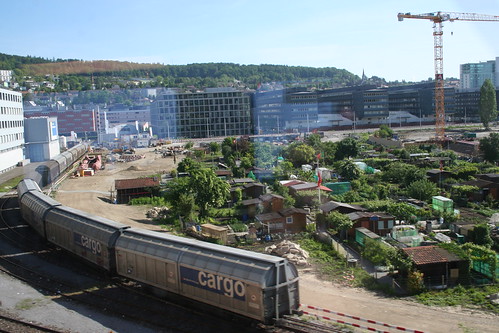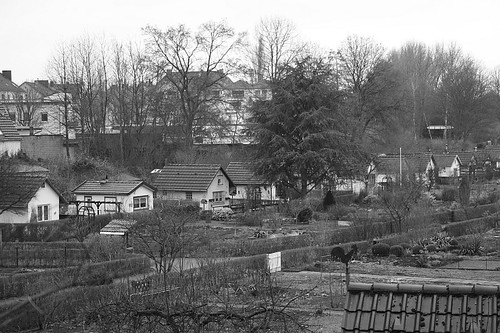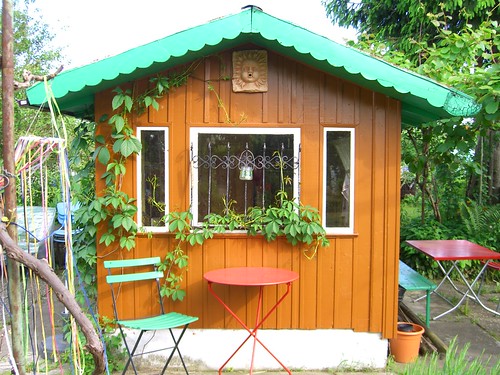The German Schrebergarten Posted by Constanze on Aug 23, 2017 in Culture, Traditions
Guten Tag! Today I’d like to talk about a little piece of German culture that you may not know about yet. This post is all about die Schrebergärten. You may recognise the word Gärten as the plural of der Garten (garden), and you’d be right in thinking we’re talking about a kind of garden. So what exactly are Schrebergärten, and where can you find them in Germany?
What are Schrebergärten?
A Schrebergarten (singular) is much like an English allotment; a small piece of land some distance away from a person’s house, where they can grow fruits and vegetables. The name ‘Schrebergarten’ comes from its history: In the 1800s a Dr. Daniel Schreber wanted to create more outdoor spaces in his hometown of Leipzig for children to exercise in, so he asked the city of Leipzig to lease small plots of land for this purpose, and the Schrebergarten was born.
However, during 1. Weltkrieg (World War 1) its primary purpose shifted; it became an invaluable area for people to grow their own food in. Furthermore, the little Schuppen (sheds) often found at the end of Schrebergärten became temporary housing solutions following the housing shortages during the 2 world wars. The way these Schuppen ‘evolved’ is most likely the reason that so many Schrebergärten nowadays look like little holiday homes rather than allotments.
Where can I find Schrebergärten, and what are they like today?
Next time you take a train journey in Germany, have a look out of the window and see if you can spot any Schrebergärten. They are usually along the train lines, outside of the city. Compared to English allotments, which can look rather messy and unkempt, the Schrebergärten (also known as Kleingärten – ‘small gardens’) are usually very neat and tidy.

Schrebergarten ‘colony’ as seen from a train window. Foto: hagengraf on flickr.com under a CC license (CC by 2.0)
In my experience, Germans love gardening and are very proud of their gardens, so it is no wonder that this extends to their Schrebergärten. A few years ago a neighbourhood I was staying in in Germany opened up their gardens to the public, like a kind of garden show, allowing people to walk through their backyards and admire their gardens. This wasn’t a big, advertised event, and there were no prizes – it was more of a social event for the neighbours to get together and look at each other’s gardens. Needless to say, each garden was pristine. Even the pretty flower boxes that hang from what seems like every German balcony show how much Germans pride themselves on their gardening skills. Personally, this is something I’ve always admired about German life.
If you would like a Schrebergarten of your own in Germany, be aware that there are strict rules on it, such as what you can and can’t grow, and even how high your hedge can be (these things are checked)! There are also other rules – for example, it must be one third planting area, one third recreational space, and one third lawn, and all weeds must be removed/trimmed back as soon as possible. You also cannot have it purely as a recreational area – you must be actually using it to grow produce. Lots of Gesetze (rules) – but that’s probably why these gardens look so nice!
If you’ve enjoyed this post and like a spot of gardening yourself, why not take a look at this post on gardening vocabulary? Looking forward to your comments and questions, as always. 🙂
Bis bald!
Constanze

Build vocabulary, practice pronunciation, and more with Transparent Language Online. Available anytime, anywhere, on any device.







Comments:
James Richards:
Hi,
I sometimes wonder whether you have ever been to the UK?, as in my experience allotments are not unkempt and scruffy as you state. For your information there is a very active organisation that can be found in an annual publication called the, “yellow gardens book”, where over 4,000 house gardens are listed which are open for people to visit and many thousands more locally.
Constanze:
@James Richards Hello James! I am from the UK. Having re-read my post I see how it may have come across that way, but I didn’t mean that all English allotments are scruffy and unkempt, just that a lot of them appear so compared to these German ones. I apologise if I offended you.
Marie:
Wie groß sind typische Kleingärten? Als ich in einer Wohnung gewohnt habe, habe ich auch einen Schrebergarten gemietet. Wasser und Streu waren mit dem 20 mal 20 Fuß Garten inklusiv, aber es gab keinen Schuppen und wenige Regeln. Statt am Stadtrand waren die Schrebergärten mitten in einem Park. Ich denke, hätte ich einen Schuppen gehabt und wenn ich meine Gartenzeuge im Garten ohne Sorgen lassen konnte, wäre ich mit dem Garten zufrieden gewesen.